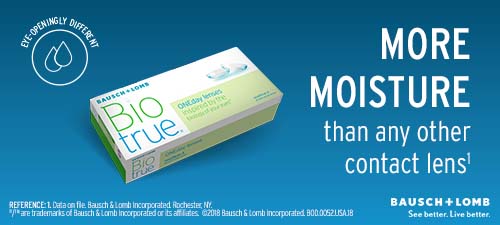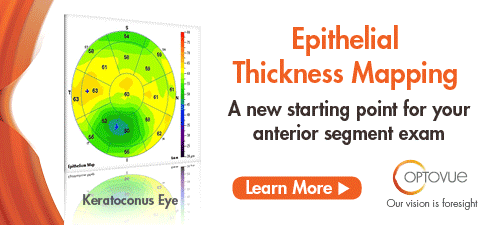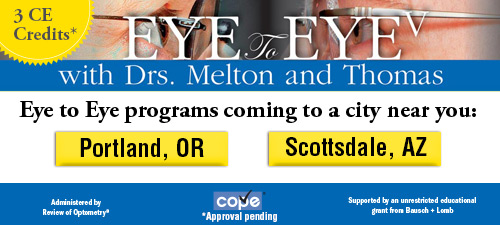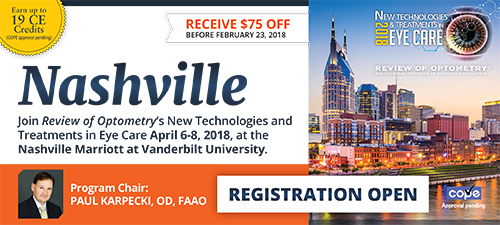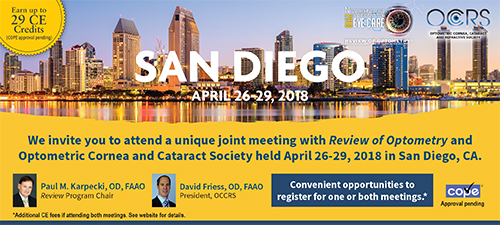
A
weekly e-journal by Art Epstein, OD, FAAO
Off the Cuff: The Lying Liars Keep on Lying
I truly believe that what goes around does eventually come around—at least most of the time. Well, when it comes to 1-800 Contacts and our dear friends at Costco (the big box giant that plays the move-what-you-need-so-you-keep-on-searching-and-buy-other-crap-you-don’t-need game), it finally has. It turns out that all of that anti-patient, anti-AOA and anti-optometry media claptrap was subversive, paid-for propaganda linked to the above-mentioned friends of honesty, decency and the American way. Next week: our last chance to stand up for patient safety and how you can make a difference.
|
|||||
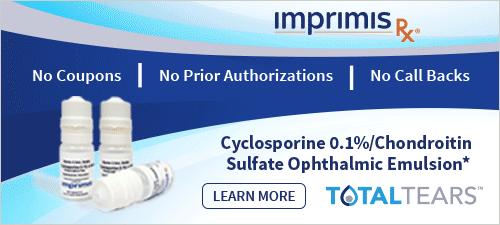
|
||
| Long-term Intraocular Pressure Elevation after Primary-angle Closure Treated with Early Phacoemulsification | ||||
A retrospective chart review of acute primary angle closure patients treated with phacoemulsification in attack eyes vs. fellow eyes were evaluated to assess long-term changes in intraocular pressure (IOP) and the development of glaucoma after early phacoemulsification in acute primary-angle closure. Within a month after the angle-closure attack, all subjects underwent cataract surgery and were divided into two groups: Group A received cataract surgery on their attack eyes. Group B also received cataract surgery on fellow eyes after phacoemulsification of the attack eyes. Study outcomes were the prevalence of IOP rise (occurrence of IOP >21 mmHg) and the incidence of newly developed glaucoma. Eighty-nine eyes were included, with 62 attack eyes in group A and 27 fellow eyes in group B. Group A (14 eyes, 22.58%) had a higher cumulative rate of IOP rise than group B (three eyes, 11.11%) at 12 months. Newly developed glaucoma was not observed in group B; however, six patients in group A developed glaucoma during the 12-month follow-up period. The attack eyes treated with phacoemulsification showed a significantly higher prevalence of IOP rise and newly developed glaucoma than fellow eyes that received phacoemulsification. These findings suggest that there is a possibility of IOP rise and development of glaucoma even when angle-closure and successful IOP control have apparently been achieved after phacoemulsification. |
||||
SOURCE: Baek SU, Kim KH, Lee JY, et al. Long-term intraocular pressure elevation after primary angle closure treated with early phacoemulsification. Korean J Ophthalmol. 2018; Mar 19. [Epub ahead of print]. |
||||
|
|||
| Analysis of Retinal Thinning Using SD-OCT Imaging of Sickle Cell Retinopathy Eyes Compared to Age- and Race-matched Control Eyes | ||||
Sickle cell and control (age- and race-matched) patients were prospectively enrolled from a university retina clinic into this observational study to determine whether the retina is thinner in sickle cell patients than in race- and age-matched controls; and if it is thinner, whether there is any association with systemic diseases. Participants underwent visual acuity testing, slit-lamp biomicroscopy, dilated ophthalmoscopy and spectral-domain optical coherence tomography imaging. Sickle cell retinal lesions, degree of vascular tortuosity, caliber of arteriovenous anastomosis and stage of retinopathy were noted. Early Treatment Diabetic Retinopathy Study (ETDRS) subfield measurements were compared between sickle cell and control subjects and also among sickle cell hemoglobin subtypes. Associations between ETDRS subfield measurements and hemoglobin subtype, retinopathy stage and systemic diseases were assessed.
A total of 513 sickle cell eyes (260 patients) and 75 control eyes (39 patients) had median visual acuities of 20/20. ETDRS central, inner and temporal outer subfield measurements were thinner in sickle cell eyes compared with control eyes. Hemoglobin SS eyes had significantly thinner inner ETDRS subfield measurements compared to SC and SThal eyes. Retinal thinning in all subfields was associated with age for sickle cell and control eyes. No association was found between retinal thinning and hydroxyurea use or arteriovenous anastomosis caliber. Researchers found that the macula was thinner in sickle cell eyes compared with control eyes; retinal thickness decreased with increasing age and sickle cell retinopathy stage, and was most severe in hemoglobin SS subtypes. |
||||
SOURCE: Lim JI, Cao D. Analysis of retinal thinning using SD-OCT imaging of sickle cell retinopathy eyes compared to age- and race-matched control eyes. Am J Ophthalmol. 2018; Mar 16. [Epub ahead of print]. |
||||
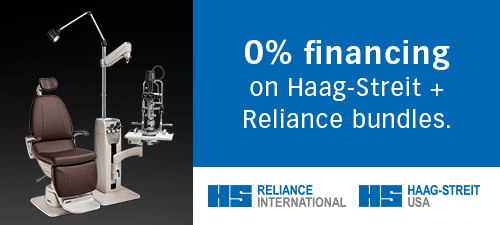
|
||
| High-definition Optical Coherence Tomography of the Macula in Deprivational Amblyopia | ||||
This cross-sectional study evaluated macular thickness in deprivational amblyopia from pediatric cataracts and compared the findings with matched controls. Macular high-definition optical coherence tomography scans of each eye were acquired. Central macular thickness (CMT) and parafoveal thicknesses at 50μm, 1,000 μm and 1,500μm in the nasal, temporal, inferior and superior locations were measured.
Thirty-four eyes were included: 14 eyes with deprivational amblyopia and 20 controls. In amblyopes, the mean age was 10.06 years ± 3.89 years and logMAR visual acuity (VA) was 0.41 ± 0.53, whereas in the control group, mean age was 8.96 years ± 1.89 years and mean logMAR VA was 0.03 ± 0.05. The macula in deprivational amblyopia was significantly thicker centrally compared with controls, but only tended to be thicker at 500μm, and thinner at 1,000μm and 1,500μm. Male gender, poorer VA and hyperopic refraction positively correlated with CMT. Eyes with deprivational amblyopia had increased CMT compared with controls, and this correlated with the severity of amblyopia. |
||||
SOURCE: Al-Haddad C, Mehanna CJ, Ismail K. High-definition optical coherence tomography of the macula in deprivational amblyopia. Ophthalmic Surg Lasers Imaging Retina. 2018;49(3):198-204. |
||||
|
|||
| News & Notes | |||||||||||||||
| FDA Approves Lucentis (Ranibizumab Injection) 0.3 Mg Prefilled Syringe for DME & DR Genentech announced that the U.S. Food and Drug Administration approved the Lucentis (ranibizumab injection) 0.3 mg prefilled syringe as a new method of administering the medicine to treat all forms of diabetic retinopathy. The Lucentis 0.3 mg PFS is the first syringe prefilled with an anti-vascular endothelial growth factor agent FDA-approved to treat both diabetic retinopathy and DME. The device—which is made of borosilicate glass and packaged in a single-use sterile, sealed tray—enables physicians to eliminate several steps in the preparation and administration process. The device, expected to be available in the second quarter of 2018, is indicated for the treatment of neovascular age-related macular degeneration, macular edema following retinal vein occlusion and myopic choroidal neovascularization. Read more.
|
|||||||||||||||
| pSivida Gets FDA NDA Nod for Durasert Treatment for Posterior Segment Uveitis pSivida’s New Drug Application for three-year Durasert treatment for posterior segment uveitis was accepted by the U.S. Food and Drug Administration for filing, and has a Prescription Drug User Fee Act date of Nov. 5, 2018. The NDA includes data from two Phase III studies that achieved primary efficacy endpoints at six months with a p value <0.001. In addition, the safety profile in individuals treated with Durasert for posterior segment uveitis was consistent with the safety profile of steroid treatments considered standard care. Read more. |
|||||||||||||||
| Supplementing Triple Combination Therapy with Oral Zeaxanthin Benefits nAMD Treatment Oral zeaxanthin supplementation of triple combination therapy for the treatment of neovascular age-related macular degeneration was comparatively effective and cost-effective to triple therapy alone, according to a study published in the Nov. 21, 2017, online edition of Journal of Clinical and Experimental Ophthalmology. Findings from the randomized, 24-month clinical trial also suggested that the addition of oral zeaxanthin further improved vision and reduced the incidence of subsequent NVAMD in fellow eyes as well as the number of treatment cycles required. Read more. |
|||||||||||||||
| Sight Sciences Names Selnick as CFO Sight Sciences announced the appointment of Jesse Selnick as chief financial officer. Selnick most recently served as chief financial officer and on the board of directors of Electric Lightwave, a private equity sponsored telecom infrastructure business, prior to its acquisition for $1.4 billion in 2017. Sight Sciences operates two business lines: surgical and non-surgical devices. Its non-surgical product portfolio consists of technologies in the advanced stages of development for dry eye disease. Read more. |
|||||||||||||||
|
|||||||||||||||
|
|||||||||||||||
|
Optometric Physician™ (OP) newsletter is owned and published by Dr. Arthur Epstein. It is distributed by the Review Group, a Division of Jobson Medical Information LLC (JMI), 11 Campus Boulevard, Newtown Square, PA 19073. HOW TO ADVERTISE |



